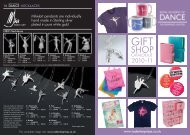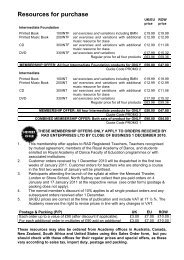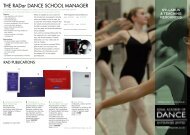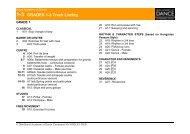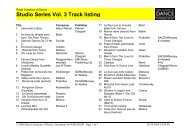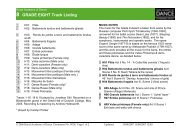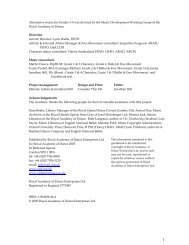Music in Focus guidebook to Alternative Music for Grades 1-3
Music in Focus guidebook to Alternative Music for Grades 1-3
Music in Focus guidebook to Alternative Music for Grades 1-3
Create successful ePaper yourself
Turn your PDF publications into a flip-book with our unique Google optimized e-Paper software.
The difference between 6/8 and 3/4<br />
Generations of dance teachers have suffered attempts by music teachers <strong>to</strong> expla<strong>in</strong><br />
<strong>to</strong> them the difference between 6/8 and 3/4 (so called ʹcompoundʹ time and ʹsimpleʹ<br />
time), but <strong>in</strong> terms of metre (rather than time signature) there is often no difference<br />
at all. The waltz from La Périchole, <strong>for</strong> example, exists <strong>in</strong> two versions <strong>for</strong> piano <strong>in</strong><br />
the onl<strong>in</strong>e American Memory Collection at the Library of Congress, one written <strong>in</strong><br />
3/4, the other written <strong>in</strong> 6/8. There are many other similar examples. No matter<br />
how it is written, however, there is no question of how it goes – which is ʹa one and<br />
a two and a three (hold four)ʹ. This pattern is a classic example of compound<br />
metre. If music notation always followed the way that the music actually sounds,<br />
then the version <strong>in</strong> 6/8 is the more ʹcorrectʹ one.<br />
<strong>Music</strong>ians – unless they happen <strong>to</strong> be <strong>in</strong>terested <strong>in</strong> the his<strong>to</strong>ry of music notation,<br />
or players of Early <strong>Music</strong>, <strong>in</strong> which time signatures are non‐existent – are<br />
frequently unaware of how arbitrary or contentious time signatures can be. As<br />
CAPLIN (2002) says,<br />
22<br />
<strong>Music</strong>ians <strong>to</strong>day are so familiar with the mechanics of note values, time<br />
signatures and metrical organisation of music of the high Baroque that it is<br />
perhaps surpris<strong>in</strong>g <strong>to</strong> discover how contentious these issues were <strong>for</strong><br />
theorists of the period. Indeed, classify<strong>in</strong>g the multitude of meters and<br />
their correspond<strong>in</strong>g time signatures used by composers…became an<br />
obsession of these theorists. Compet<strong>in</strong>g schemes based on various<br />
underly<strong>in</strong>g pr<strong>in</strong>ciples were vehemently attacked and defended.<br />
CAPLIN, 2002, p. 661<br />
Ironically, what prompted the issue of how <strong>to</strong> notate metres and convert them<br />
<strong>in</strong><strong>to</strong> time signatures was a fasc<strong>in</strong>ation with dance, and a sense that the motion and<br />
rhythms of dances were so important <strong>to</strong> music, that any student composer should<br />
make it their job <strong>to</strong> understand dance. As if <strong>to</strong> prove this po<strong>in</strong>t, the music of the<br />
baroque composer Johann Sebastian Bach is full of dances and dance rhythms, a<br />
subject which is explored <strong>in</strong> great depth with many examples by LITTLE AND<br />
JENNE (2001). This book is <strong>in</strong>valuable as a guide <strong>to</strong> baroque dance and music, as it<br />
is one of the few <strong>in</strong> which both aspects are discussed <strong>in</strong> similar measure.<br />
Ambiguous waltzes<br />
Depend<strong>in</strong>g on the style and tempo <strong>in</strong> which they are played, or what movements<br />
are per<strong>for</strong>med <strong>to</strong> them, some waltzes can feel as if they are either <strong>in</strong> 3 or <strong>in</strong> 6.<br />
Examples of this are the waltz from La Belle Hélène, by Offenbach (used <strong>in</strong> Grade 2<br />
Sways with arm circles) the Brudevals by Gade (used <strong>in</strong> Grade 3 Balancés de côté<br />
female exercise), or the Dronn<strong>in</strong>g Louise Vals by Lumbye, used <strong>in</strong> Grade 3<br />
Battements tendus and demi‐de<strong>to</strong>urnés).<br />
Furthermore, there is hardly a s<strong>in</strong>gle waltz by Tchaikovsky which fits neatly <strong>in</strong><strong>to</strong><br />
one category or the other, <strong>to</strong> the extent that it seems likely that he was constantly<br />
experiment<strong>in</strong>g with the <strong>for</strong>m, try<strong>in</strong>g his best (successfully, as it turned out) <strong>to</strong>



